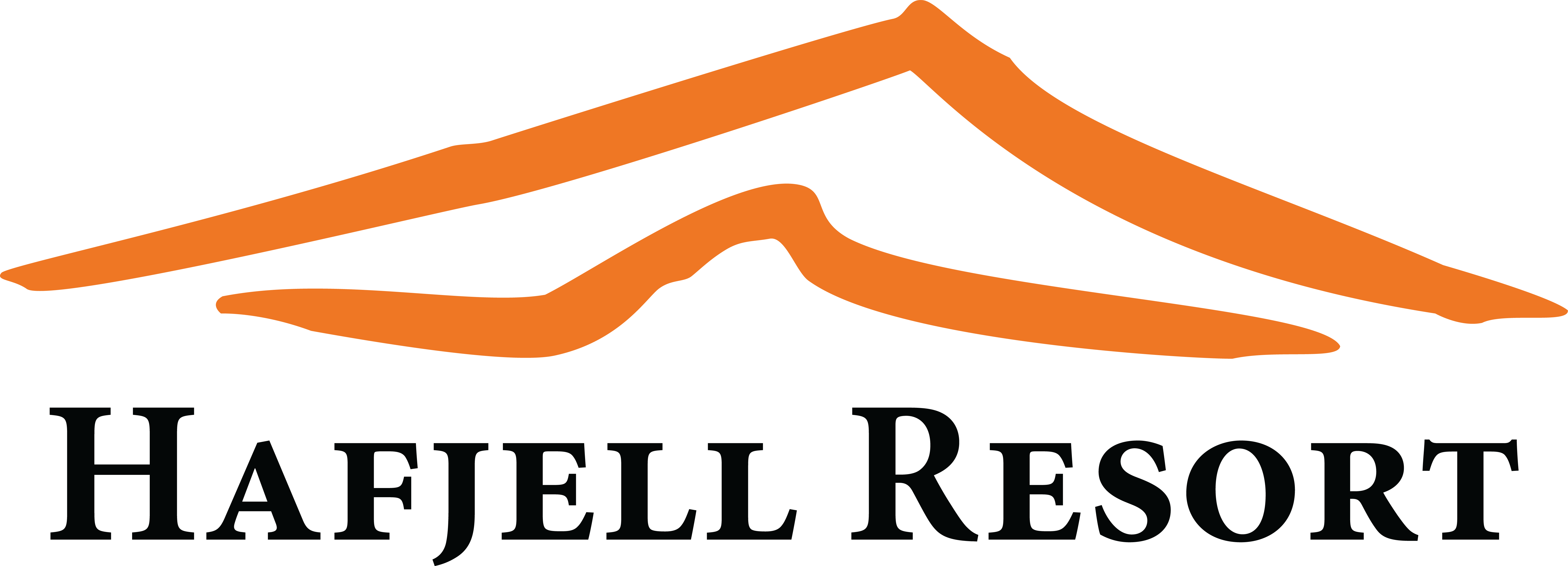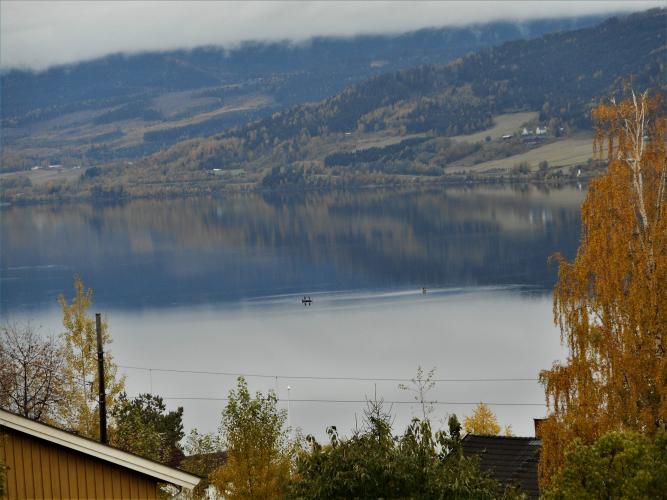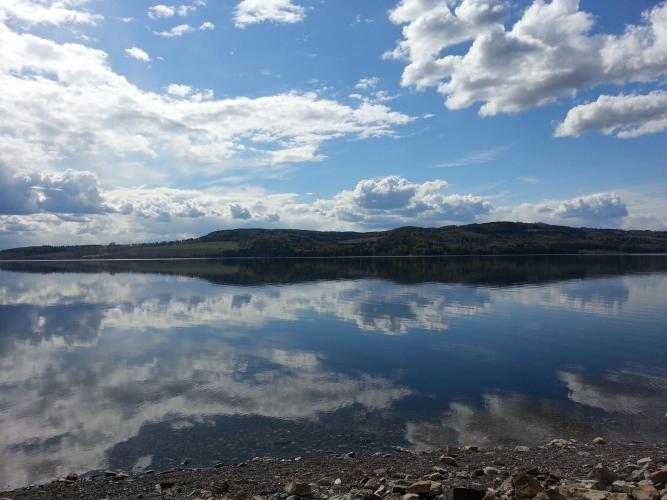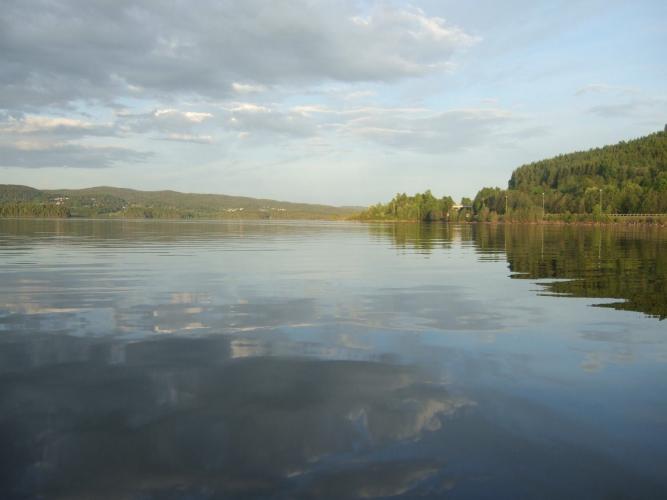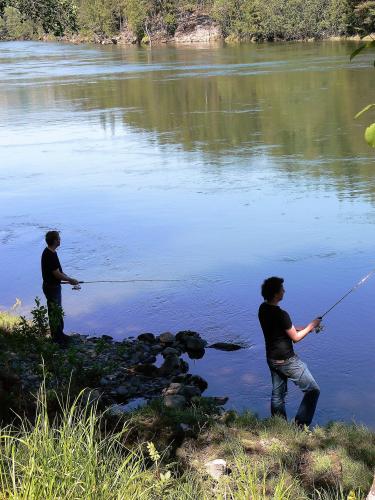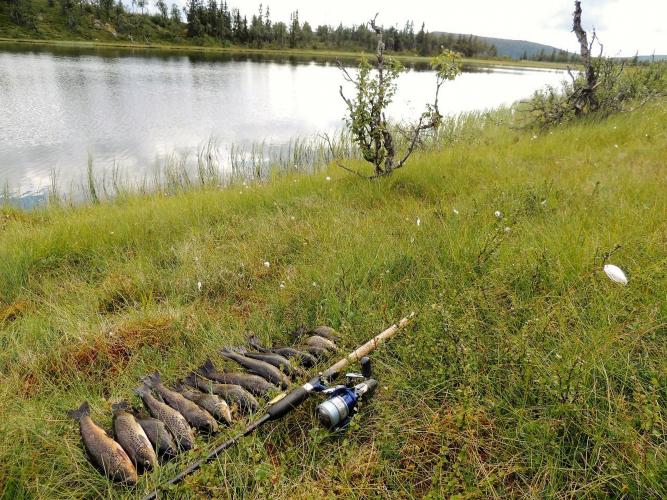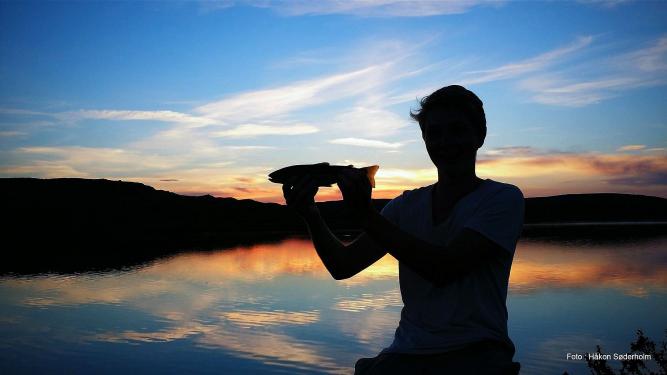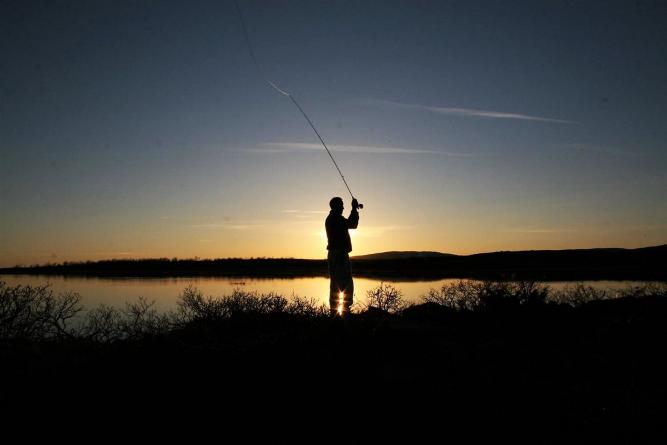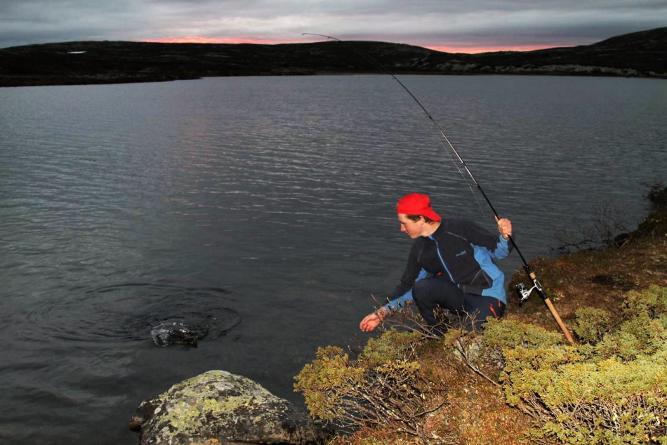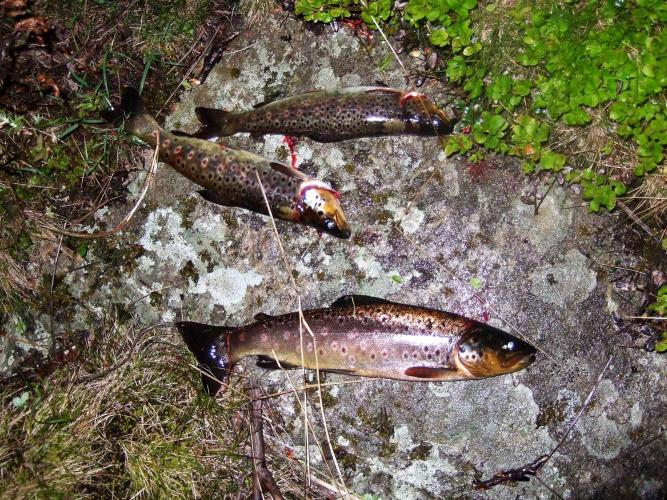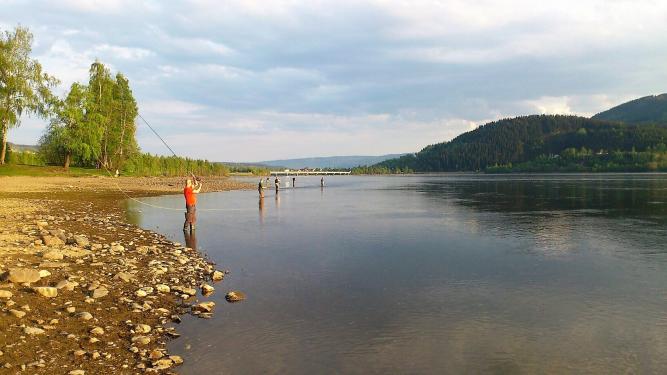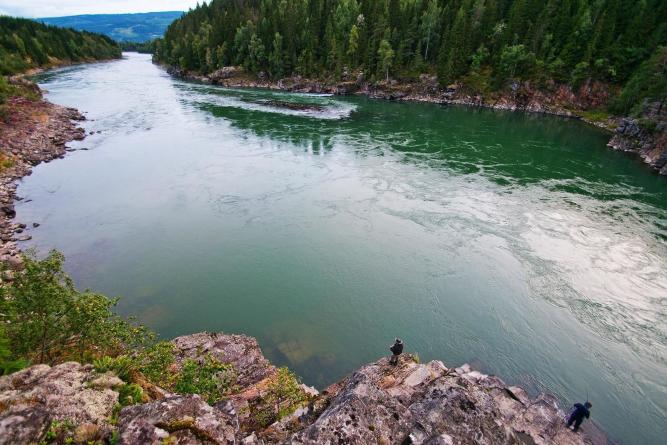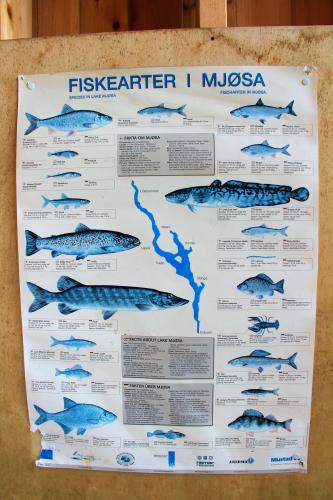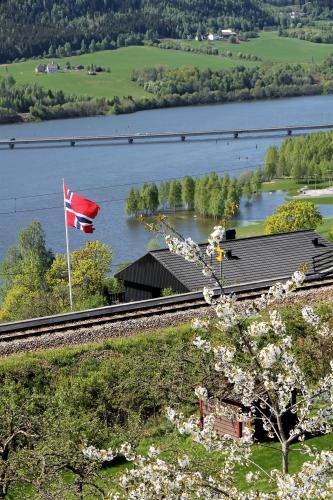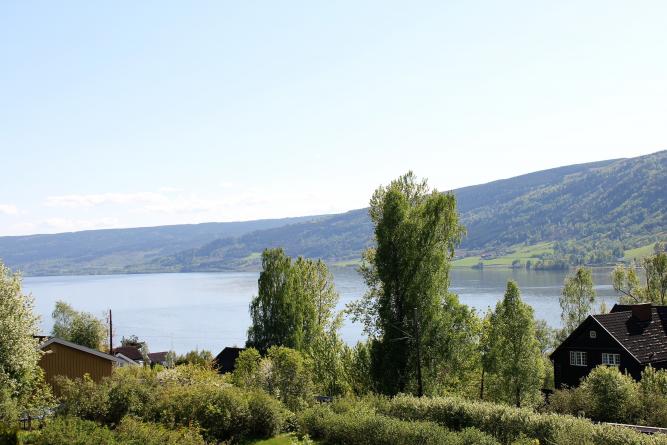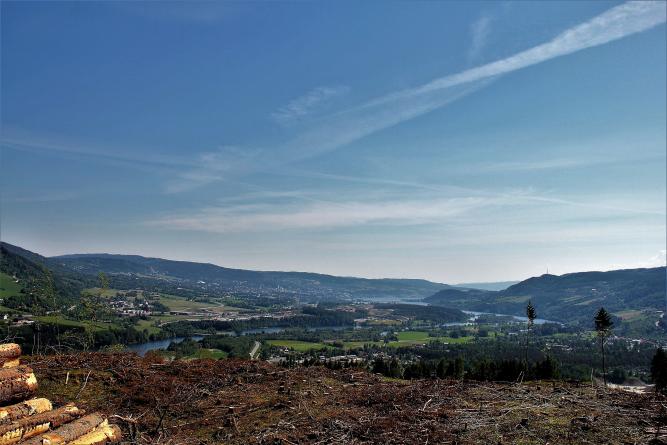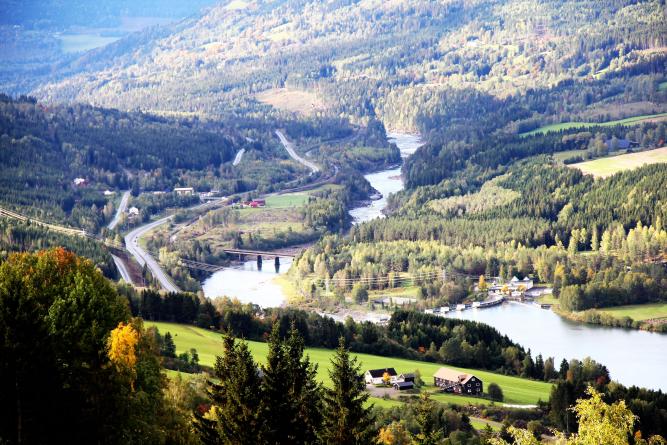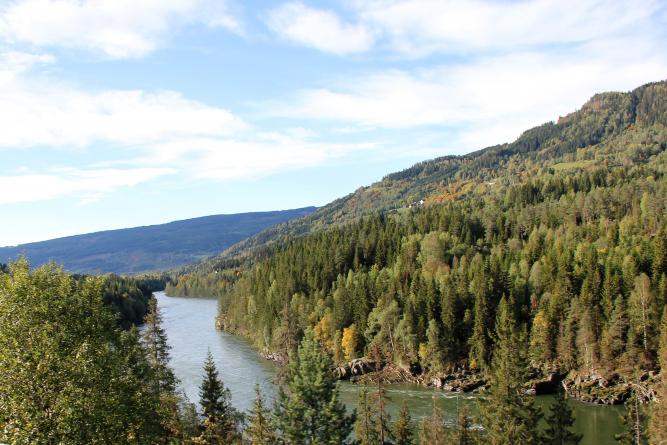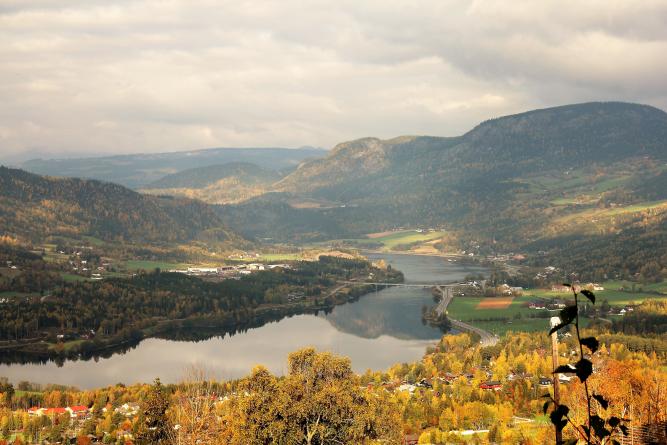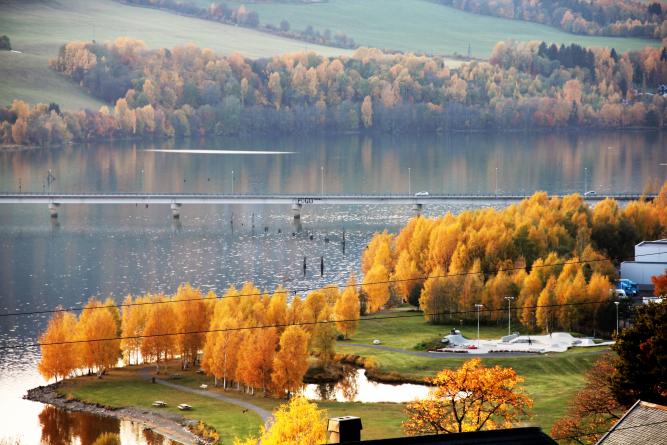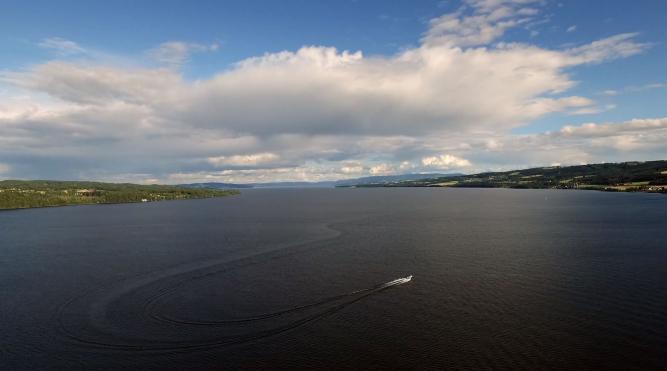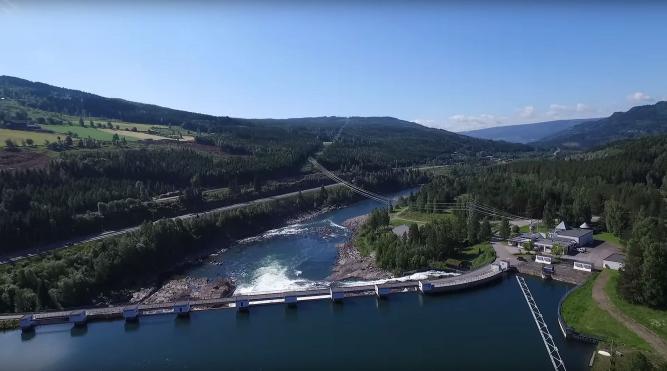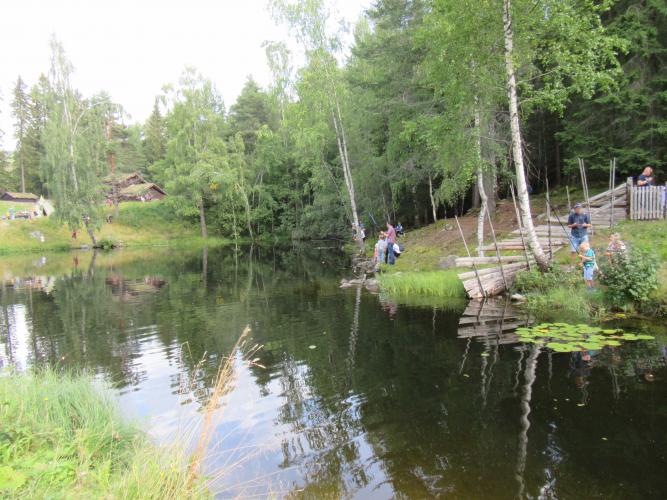Fishing in Norway
Fishing in lake Mjøsa an Lillehammer area. As a host to 20 different fish species, Lake Mjøsa is among the top lakes in Norway as far as varied fishing is concerned. Even though the majority of Lake Mjøsa's fish species can be traced back to "immigrants from the East", the family salmonidae clearly dominate, when it comes to fish quantity. Lake Mjøsa has one of Europe's largest populations of large Brown Trout.
Lake Mjøsa
Lake Mjösa is the largest lake of Norway and has a surface on, 336 square km. The maximum depth of Mjösa is 443 meters. Lake Mjösa borders to three counties and seven municipalities.
The length of the lake is 117 km, and the total length of the shoreline is 273 km. 90 km of the shoreline is covered by forests and 80 km by agricultural land.
Railroad and main roads passes near the shoreline in lengths of 35 and 28 km, 6 km is covered by cabins, 16 km is built up areas and 3 km is steep mountains. Only 20 % of the shoreline is accessable to the public.
There are strong traditions to common use of both the lake and the surroundings. The area is of great importance for recreation, both for local people and tourists.
Parts of the area are of great importance to building preservation and archaeology.
Fishing in lake Mjøsa an Lillehammer area. As a host to 20 different fish species, Lake Mjøsa is among the top lakes in Norway as far as varied fishing is concerned. Even though the majority of Lake Mjøsa's fish species can be traced back to "immigrants from the East", the family salmonidae clearly dominate, when it comes to fish quantity. Lake Mjøsa has one of Europe's largest populations of large Brown Trout.
This breed consist of several different stocks with its own spawning rivers and brooks. There are in fact more than 40 rivers and brooks around Lake Mjøsa, each of them hosting its own unique stock of Mjøsa Brown Trout, and all using Lake Mjøsa as the feeding ground for growing big. The size of the particular lokal stock is biologically adapted to the river/brook of origin. The size and distinctive characteristics of the Mjøsa Brown Trout are due to several natural conditions:
Lake Mjøsa's topographical conditions with its large volume of water and great depths
The Lake's large number of good spawning rivers/brooks.
The Lake's rich abundance of prey fish, especially Sparling and Vendance.
From the book "Vannkvalitet i Mjøsa, før og nå" (The Water Quality in LAke Mjøsa, Before and Now) by Ole Nashoug.
Fishing in Lillehammer
Almost all of the 20 fish species living in Lake Mjøsa are also represented in the Lågendelta by Lillehammer. This offers a varied opportunity for angling throughout the ice-free season. The Grayling is the fish most wanted, offering a great catch from April until October. The season for Grayling starts with dry fly-fishing between the ice-flakes in the month of April. During spring time flood, in the month of May, the angling starts.
The method of fly-fishing is the most popular during summertime and autumn. Hunder Brown trout, representing the greatest breed of Big Brown, is not easily taken and offers the most challending as well as exclusive fishing experiences. Every year spesimens from 8 to 12 kilos are caught by rod.
Both Pike and Burbot are wanted by anglers - offering exciting moments and not least big fishes. In the evenings of February and March, ice fishing for Burbot, south of the bridge Vingnesbrua, often rewards you with a goog catch. This predatory fish must be decoyed with fish bites along the bottomline. With the magnificent lights from the olympic city and the stable lanterns around the jig holes, the setting for this angling at evening times is marvellous.
Being particularly ferocious after the spawning, during the flood period, the Pike may, with its powerful snappings and quick-tempered fury, be a challenge to anglers. During springtime and in the early part of summer, the angling for species of Carp, such as Ide and Bream in the Lågendelta offers yoy a goog catch of fishes from 1 to 3 kilos. This kind of angling is also suitable for family activities as well as for the specialized angler. At this time of year, anglers catch quite a few Big Perch too.
Fishing in Ringsaker
The angling activity in the area of Ringsaker is taken care of by the fish and game association, Ringsaker Jakt- og Fiskeområde (RJFO), consisting of the properties of Philske Sameie and the Commons of Brøttum, Ringsaker, Veldre, Nes and Furnes, and area of around 600 squarekilometres in total. RFJO runs an active fish cultivation and no less than 20 artificial fishing lakes have been constructed. In addition to these artificial waters, the RFJO is the owner of just as many natural waters/small lakes, 40 lakes all in. Nice spots are available both for anglers as well as for families. Many of the articial waters have been built next to the road, and therefore being within easy reach for the whole familiy.
Gudbrandsdalslågen river
The Gudbrandsdalslågen river is one of Norway's best river for angling. With more thank 50 lakes and 100 kilometres of rivers and streams in the mountains in Lillehammer area to choose from, you can catch everything from perch, grayling, pike, powan and locale Mjøs trout.
Gudbrandsdalslågen is 300 kilometres long and is h2ided into nine zones. "Lågen" as it is called for short, is a wide river with all types of environment, from slow-flowing sections to vigorous rapids, but it is the slow-flowing stretches with flat silt and gravel bottom conditions which dominate.
Lågen generally has two flood periods each year. The first comes in May but does not discolour the water to the same extent as the more powerful flood which normally occurs in July, as a result of the snow melting in the high mountains. This flood contains silt from the glaciers of the Jotunheimen mountains, whose fine clay particles suspended in the water reflect light, giving rise to a chareacteristic green colour.
Fish Species
Trout, grayling, whitefish (powan and vendace), perch, pike, smelt, bream, orfe, roach, dace, crucuan carp, bleak, minnows, bullhead, nige-spinned stickleback, ruffe and lamprey.
Advice and hints
In May and June, Lågen offers good grayling angling, the sport being particularly good during the early spring flood. Worm and nymph fishing often produce good catches.
Lake Mjösa is the largest lake of Norway and has a surface on, 336 square km. The maximum depth of Mjösa is 443 meters. Lake Mjösa borders to three counties and seven municipalities.
The length of the lake is 117 km, and the total length of the shoreline is 273 km. 90 km of the shoreline is covered by forests and 80 km by agricultural land.
Railroad and main roads passes near the shoreline in lengths of 35 and 28 km, 6 km is covered by cabins, 16 km is built up areas and 3 km is steep mountains. Only 20 % of the shoreline is accessable to the public.
There are strong traditions to common use of both the lake and the surroundings. The area is of great importance for recreation, both for local people and tourists.
Parts of the area are of great importance to building preservation and archaeology.
Fishing in lake Mjøsa an Lillehammer area. As a host to 20 different fish species, Lake Mjøsa is among the top lakes in Norway as far as varied fishing is concerned. Even though the majority of Lake Mjøsa's fish species can be traced back to "immigrants from the East", the family salmonidae clearly dominate, when it comes to fish quantity. Lake Mjøsa has one of Europe's largest populations of large Brown Trout.
This breed consist of several different stocks with its own spawning rivers and brooks. There are in fact more than 40 rivers and brooks around Lake Mjøsa, each of them hosting its own unique stock of Mjøsa Brown Trout, and all using Lake Mjøsa as the feeding ground for growing big. The size of the particular lokal stock is biologically adapted to the river/brook of origin. The size and distinctive characteristics of the Mjøsa Brown Trout are due to several natural conditions:
Lake Mjøsa's topographical conditions with its large volume of water and great depths
The Lake's large number of good spawning rivers/brooks.
The Lake's rich abundance of prey fish, especially Sparling and Vendance.
From the book "Vannkvalitet i Mjøsa, før og nå" (The Water Quality in LAke Mjøsa, Before and Now) by Ole Nashoug.
Fishing in Lillehammer
Almost all of the 20 fish species living in Lake Mjøsa are also represented in the Lågendelta by Lillehammer. This offers a varied opportunity for angling throughout the ice-free season. The Grayling is the fish most wanted, offering a great catch from April until October. The season for Grayling starts with dry fly-fishing between the ice-flakes in the month of April. During spring time flood, in the month of May, the angling starts.
The method of fly-fishing is the most popular during summertime and autumn. Hunder Brown trout, representing the greatest breed of Big Brown, is not easily taken and offers the most challending as well as exclusive fishing experiences. Every year spesimens from 8 to 12 kilos are caught by rod.
Both Pike and Burbot are wanted by anglers - offering exciting moments and not least big fishes. In the evenings of February and March, ice fishing for Burbot, south of the bridge Vingnesbrua, often rewards you with a goog catch. This predatory fish must be decoyed with fish bites along the bottomline. With the magnificent lights from the olympic city and the stable lanterns around the jig holes, the setting for this angling at evening times is marvellous.
Being particularly ferocious after the spawning, during the flood period, the Pike may, with its powerful snappings and quick-tempered fury, be a challenge to anglers. During springtime and in the early part of summer, the angling for species of Carp, such as Ide and Bream in the Lågendelta offers yoy a goog catch of fishes from 1 to 3 kilos. This kind of angling is also suitable for family activities as well as for the specialized angler. At this time of year, anglers catch quite a few Big Perch too.
Fishing in Ringsaker
The angling activity in the area of Ringsaker is taken care of by the fish and game association, Ringsaker Jakt- og Fiskeområde (RJFO), consisting of the properties of Philske Sameie and the Commons of Brøttum, Ringsaker, Veldre, Nes and Furnes, and area of around 600 squarekilometres in total. RFJO runs an active fish cultivation and no less than 20 artificial fishing lakes have been constructed. In addition to these artificial waters, the RFJO is the owner of just as many natural waters/small lakes, 40 lakes all in. Nice spots are available both for anglers as well as for families. Many of the articial waters have been built next to the road, and therefore being within easy reach for the whole familiy.
Gudbrandsdalslågen river
The Gudbrandsdalslågen river is one of Norway's best river for angling. With more thank 50 lakes and 100 kilometres of rivers and streams in the mountains in Lillehammer area to choose from, you can catch everything from perch, grayling, pike, powan and locale Mjøs trout.
Gudbrandsdalslågen is 300 kilometres long and is h2ided into nine zones. "Lågen" as it is called for short, is a wide river with all types of environment, from slow-flowing sections to vigorous rapids, but it is the slow-flowing stretches with flat silt and gravel bottom conditions which dominate.
Lågen generally has two flood periods each year. The first comes in May but does not discolour the water to the same extent as the more powerful flood which normally occurs in July, as a result of the snow melting in the high mountains. This flood contains silt from the glaciers of the Jotunheimen mountains, whose fine clay particles suspended in the water reflect light, giving rise to a chareacteristic green colour.
Fish Species
Trout, grayling, whitefish (powan and vendace), perch, pike, smelt, bream, orfe, roach, dace, crucuan carp, bleak, minnows, bullhead, nige-spinned stickleback, ruffe and lamprey.
Advice and hints
In May and June, Lågen offers good grayling angling, the sport being particularly good during the early spring flood. Worm and nymph fishing often produce good catches.
Read more
Contact information
- +47 61289800
- Jernbanegata 2 - 2609 - Lillehammer
